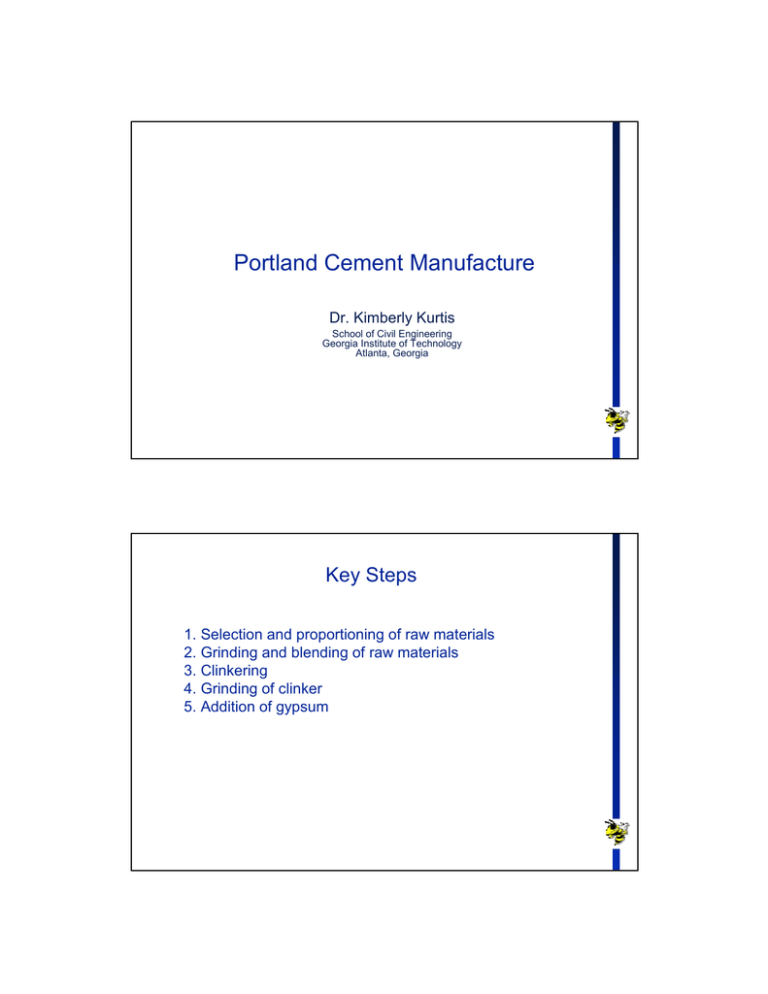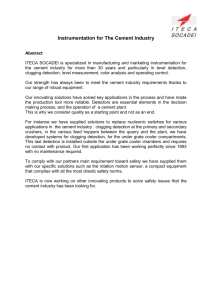Portland Cement Manufacture
advertisement

Portland Cement Manufacture Dr. Kimberly Kurtis School of Civil Engineering Georgia Institute of Technology Atlanta, Georgia Key Steps 1. Selection and proportioning of raw materials 2. Grinding and blending of raw materials 3. Clinkering 4. Grinding of clinker 5. Addition of gypsum Raw Materials Portland cement is: 45-60% C3S 15-30% C2S 6-12% C3A 6-8% C4AF Calcium Iron Silica Alumina Sulfate Alkali waste Aragonite Calcite Cement-kiln dust Cement rock Chalk Clay Fuller’s earth Limestone Marble Marl Seashells Shale Slag Blast-furnace flue dust Clay Iron ore Mill scale Ore washings Pyrite cinders Shale Calcium silicate Cement rock Clay Fly ash Fuller’s earth Loess Marl Ore washings Quartzite Rice-hull ash Sand Sandstone Shale Slag Traprock Aluminum-ore refuse Bauxite Cement rock Clay Copper slag Fly ash Fuller’s earth Granodiorite Limestone Loess Ore washings Shale Slag Staurolite Anhydrite Calcium sulfate Gypsum Raw Materials Raw Materials Raw Materials CaO-SiO2 Binary Phase Diagram CaO-Al2O3 Binary Phase Diagram Raw Materials Grinding and Blending • Because the objective is to fuse the raw materials at high temperature, but with energy conservation, the size of the raw materials is critical. • Feedstock materials with the same chemical composition but different size fractions can require different firing temps (by as much as 150oC) to achieve an acceptable degree of reaction . •Therefore the materials must be finely and uniformly ground to achieve burning at the lowest possible temperature. - saves fuel - prolongs the life of the refractory (heat-resisting ceramic material which line the kiln) - achieves a more uniform product Grinding and Blending ~5” ~3/4” • The more work done by crushing, the less work necessary during further milling (energy savings) Grinding and Blending: Wet Process ~1/8” powder (<90um) • After crushing, powders are mixed with water (35-50% by mass) • Slurries of varying composition are mixed in specific proportions Grinding and Blending: Dry Process 800oC Grinding mill Vertical roller mill Sintering or Clinkering • 1-4% inclined rotary kiln, 1-4 rev./min. •Wet process kilns can be up to 8m in diameter and as long as 230 m. •Typical dimensions are 50-100m long, and 3-10m diam. Clinkering: Reactions Clinkering: Reactions Clinkering: Reactions • Production of 1 ton of cement, results in release of ~ 1 ton CO2. Clinkering: Reactions Clinkering: Reactions Clinkering: Wet vs. Dry Process • Wet process requires 500 lbs of coal to produce 1 ton of cement (1400 kcal or 5700 kJ energy/kg cement). • Dry process requires less than half as much energy. • Smaller kilns can be used in more modern dry-process cement manufacture. Clinkering: Wet vs. Dry Process Wet Process Dry Process Note 1: Cement Kiln Dust • Release of cement kiln dust (CKD) is carefully controlled • Can be precipitated and used in concreting • Very high alkali content Note 2: Fuels Used • Fuel used for cement manufacture amounts to 6-8% of the world’s fuel consumption! •Since fuel costs amount to about 40-60% of the manufacturing costs, fuels are often selected on an economic basis, although other considerations may also be made. • Acquisition of the raw materials represents only 10% of the cost in comparision. • Fuels used include: - natural gas (2%) - oil (7%) - coal (70%+) - trash, including wood chips, tires, rice husks, oil-soaked Fuller’s earth, etc. (20%+) Grinding of Clinker •Upon exit from the kiln, the clinker, which is black and glistening, is cooled and then interground with gypsum. •The rate of cooling affects the degree of crystallization of the material. •Modern cement plants rapidly cool the clinker to retain as much amorphous material as possible. Kiln Grinding of Clinker Red - C3S Aqua - C2S Green - C3A Yellow - C4AF Pale green - gypsum White - free lime (CaO) Dark blue (purple) - K2SO4 Light magenta- periclase (magnesium containing phase). Image is 256 µm x 200 µm. Two-dimensional processed SEM/X-ray image for cement 133 issued by the CCRL (NIST) in June of 1999. Griding of Clinker: Influence of Fineness Addition of Gypsum • ~ 5%Gypsum (CaSO4•2H2O) is added to prevent “flash set” of cement • Slows the otherwise very fast reaction of the C3A phase • Interground with clinker in a ball mill (finish mill) Clinker Cement + Ball Mill Gypsum Grinding and Addition of Gypsum • Ground cement typically transported in bulk • Can also be sold in barrels or 94-lb. bags (“sacks”) Great Web Reference http://www.cement.org/basics/images/flashtour.html Question • Now that we have an understanding of how cement is produced commercially, how might we make it in the lab? Why would we want to do so?





